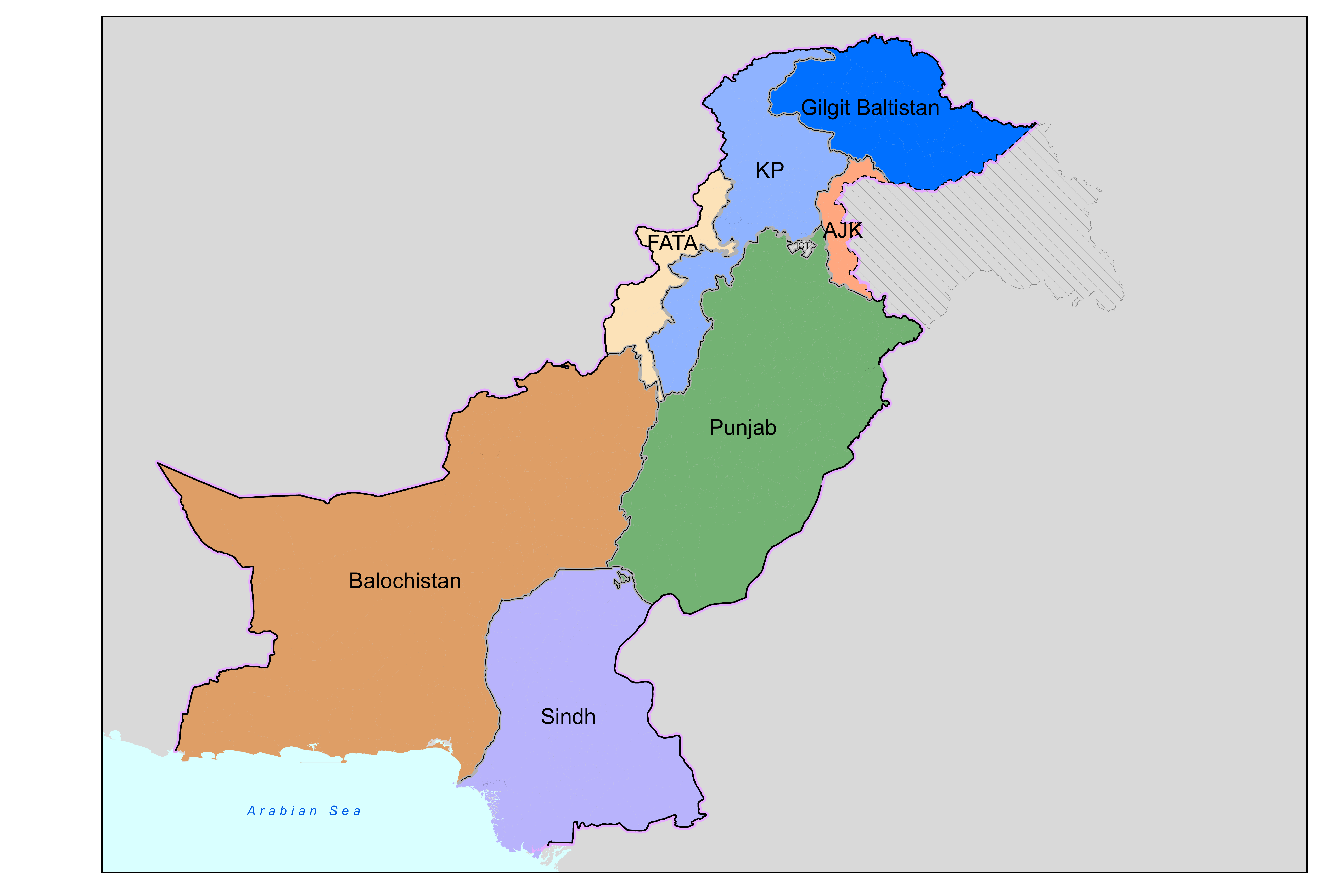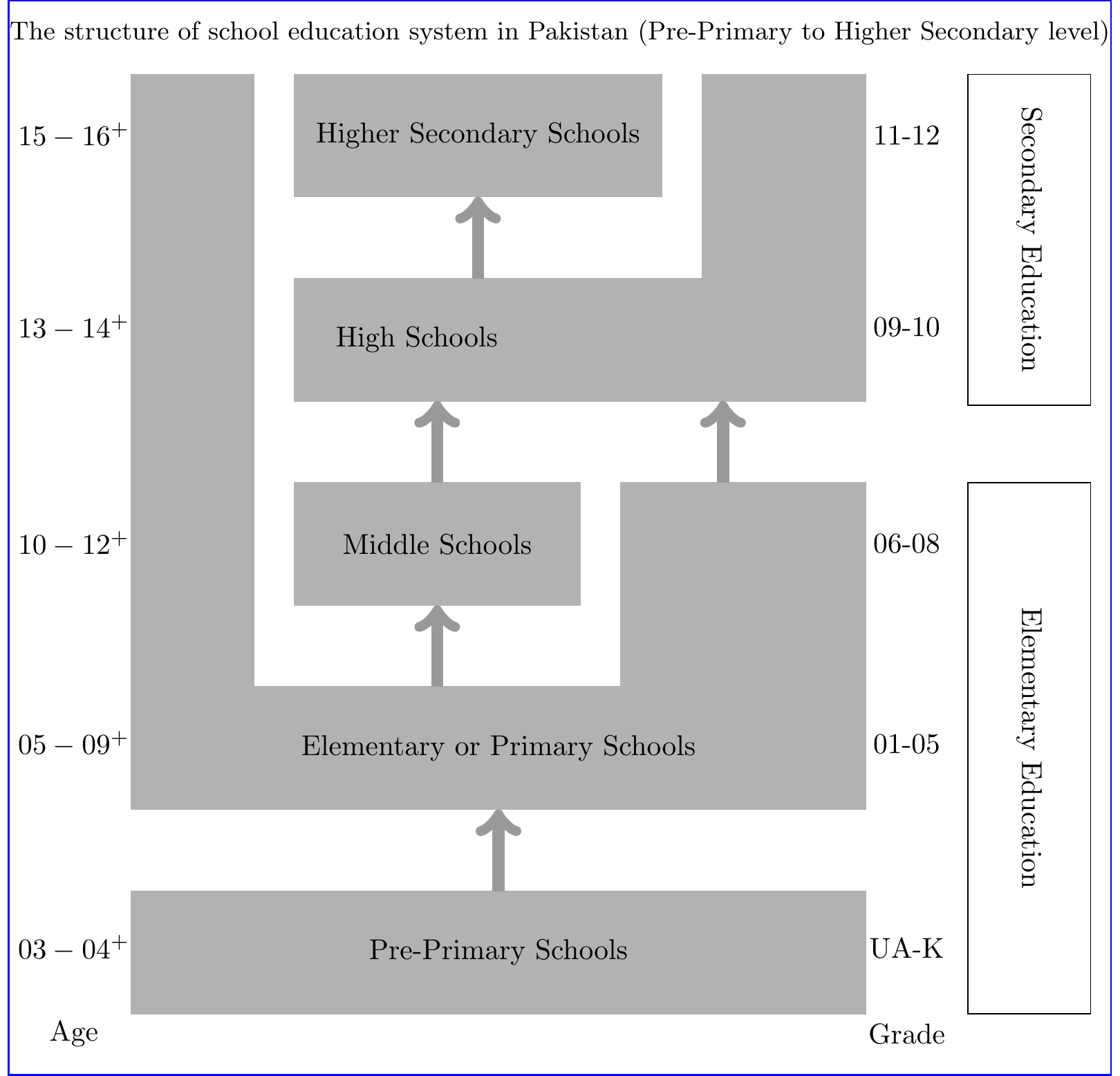1 Introduction
1.1 Introduction
The Islamic Republic of Pakistan came into being on 14th August 1947. It covers an area of about 796,096 \(\text{km}^{2}\) and shares its borders with China, India, Iran and Afghanistan.
Pakistan is located at a very strategically important position in South Asia. It connects the Eastern world with the West. It has friendly trade relations with China, an economic and technology giant, in its north. Afghanistan and Iran are in its west. India which shares long historical and cultural traditions with Pakistan lies in the East. It has a coastal belt of about 700 km, which connects it to the Middle East and provides a trade route through the Arabian Sea.
Currently Pakistan is the fifth most populous country of the world. People who are daring and passionate make up to about 212 million of this country with a population density of 246 persons /\(\text{km}^{2}\) (Pakistan Economic Survey, 2018-19).
This country has been blessed with a variety of natural resources like salt, gypsum, coal, oil, copper and gold. Its physical features like its planes, deserts, northern highlands, lakes and rivers are not only a tourist’s attraction but are also related to renewable energy resources like Hydro-Power dams, Wind Power Energy Production and Solar Power Parks.

Figure 1.1: Map of Pakistan showing different Provinces/Regions
Pakistan is an agricultural country. Its major exports include agricultural products like cotton, sugar, rice, and textiles. Sports goods and leather products are widely accepted exports all over the world. The literacy rate of the country is nearly 62 percent while youth literacy rate is even better at 74 percent (Labour Force Servey, 2017-18). Urdu is the National language of Pakistan whereas English is used for education, trade and other administrative purposes all over the country. Pakistan is home of some of the earliest human civilizations in South Asia, including the Indus Valley and Gandhara civilizations. It lies between \(23-35^{\circ}\) to \(37-05^{\circ}\) north latitude and \(60-50^{\circ}\) to \(77-50^{\circ}\) east longitude.
The principal source of water of Pakistan is the Indus River that starts in China, and runs through the whole length of Pakistan, coursing through the greater part of Pakistan’s areas aside from Balochistan. It is incremented further by the consolidated waters of the Chenab and Jhelum rivers. Along the Indus and its tributaries are majority of Pakistan’s populace horticultural zones, and its major hydroelectric power stations, interconnected by the rural waterways before it releases into the Arabian Sea.
According to Human Development Report 2017, Pakistan’s Human Development Index (HDI) value is 0.562 — elevated from low human development to the medium human development category — positioning the country at 150th out of 189 countries and territories. Between 1990 and 2017, Pakistan’s HDI value increased from 0.404 to 0.562, an increase of 39 percent or average annual increase of about 1.4 percent. Pakistan’s 2017 HDI is below the average of 0.645 for countries in the medium human development group and also below the average of 0.638 for countries in South Asia. Since the state of education in the country is a major contributor in the formulation of HDI, therefore it is required that the government must focus and invest more resources for the development of education sector.
1.2 Education System in Pakistan
The Constitution of Islamic Republic of Pakistan, 1973 lays down that State shall be responsible for eradication of illiteracy and provision of free and compulsory education up to secondary level, within minimum possible time (Article 37-B, 1973 Constitution of Pakistan)
The Article 25-A – Right to Education – of the Constitution states that:
The State shall provide free and compulsory education to all children of the age of five to sixteen years in such manner as may be determined by law.
Education is a fundamental human right and every child is entitled to it. Education is critical for the development of individuals and society, necessary for a successful and productive future. Provision of inclusive and equitable quality education, positively impacts future generations. However, education has not received due attention that it deserves in the national priorities. The present government has set up the following four strategic priority areas as:
- Decrease OOSC & increase school participation
- Uniformity in education standards
- Improve the quality of education, and
- Enhance access to & relevance of skills training
The key to success would be putting in place necessary measures for achieving set targets, including increased allocation of financial as well as human resources for the education sector. There is need to bring in place national cohesion, effective use of available information, improved governance and financial efficiency/discipline as well as innovative use of technology and communication to revamp the existing system of education according to the needs of modern era. The state has the responsibility to equip its young people with knowledge, creativity, critical thinking, technical and leadership skills so that they can play a responsible role as global citizens both nationally and internationally.
Pakistan, along with other countries of the world has signed the Sustainable Development Goals Agenda 2030. SDG-4 relates to quality education and lifelong learning. Various levels and dimensions of monitoring frameworks have been defined to better monitor the SDG-4 at national and global levels. The monitoring system that provides in-depth specifics of education system offers greater opportunities to policy makers for their unique circumstances and development priorities. As Pakistan was unable to achieve the Education For All (EFA) agenda by 2015, unfinished business of EFA will be an integral part of SDGs Agenda 2030.
On the EFA Education Development Index (EDI) published in EFA Global Monitoring Report 2015, Pakistan lies at the bottom in the region. A similar picture is painted by the gross enrolment ratios that combine all education sectors, and by the adult literacy rate measures.
According to data from the World Economic Forum’s Global Competitiveness Report 2017-18, the Global Competitiveness Index (GCI) shows Pakistan’s weak performance being ranked 129th of the 137 countries, on the Health and Primary Education related elements of competitiveness, when compared with other countries in the region like India, China, Bangladesh, Sri Lanka and Malaysia.
The structure of school education system in public sector is depicted in Fig. 1.2.

Figure 1.2: The structure of school education system in Pakistan (Pre-Primary to Higher Secondary
1.3 National Education Management Information System
The Academy of Educational Planning and Management (AEPAM) was established in 1982, mainly assigned with the responsibilities of capacity building of educational planners and managers, consolidating and collating education statistics, maintaining comprehensive national educational database and conducting policy research to facilitate preparation of educational policies.
The National Education Management Information System (NEMIS) was established in 1990 with the responsibility to collate, consolidate, and analyze national education data and generate useful information to cater to the needs of policy makers, planners, education managers and decision makers. Since 1992-93, NEMIS has been publishing Pakistan Education Statistics on annual basis. NEMIS is also providing educational data and indicators to the Government of Pakistan as well as other relevant stakeholders and UN Agencies under its global commitments.
After the devolution of Ministry of Education as a result of 18th Constitutional Amendment, NEMIS came on the front and took the major responsibilities of the defunct Policy and Planning Wing of devolved Ministry of Education.
NEMIS is also publishing the following reports on annual basis:
- Pakistan Education Atlas
- District Education Profiles
1.4 Data Compilation Mechanism
The Provincial/Area EMIS units are responsible for collection, compilation, analysis and dissemination of education statistics/data of their respective provinces/areas. These units usually collect data through their district EMIS cells by conducting Annual School Census (ASC).
The 35th Technical Committee (TechCOM) Meeting of NEMIS was held on 2nd May, 2019 at AEPAM, Islamabad. This meeting was followed by 21st Coordination Committee (CoordCOM) on 3rd May, 2019 at the same venue and participants of the TechCOM were also present in the CoordCOM Meeting. During TechCOM meeting, the technical members of provincial/area EMIS’s transformed their data into NEMIS database while members of CoordCOM meeting endorsed the numbers/data provided/compiled during TechCOM meeting.
1.5 Data Limitations
The numbers shown in this publication were tabulated from National EMIS databank developed by National Education Management Information System. These data have some limitations that need to be mentioned.
The data from private sector of education, for the provinces/regions of Sindh and Balochistan, used in this publication is based on estimation on National Education Census (NEC) data collected during NEC 2005-06. AJK EMIS has provided private sector data.
The current population census was conducted in 2017. However, the data of the population census has not yet been released by Pakistan Bureau of Statistics. Therefore, projected population data provided by National Institute of Population Studies (NIPS) based on 1998 population census is used in this publication to calculate different indicators for Pakistan Education Statistics 2017-18.
1.6 Data Sources
The following data sources have been used for compilation of this report:
- Provincial/Regional EMISs
- National Institute of Population Studies (NIPS)
- National Education Census 2005‐06
- Pakistan Bureau of Statistics (PBS)
- Higher Education Commission (HEC)
- Provincial Higher Education departments
- National Vocational & Technical Training Commission (NAVTTC), Islamabad
- National & Provincial Education Foundations
- National Commission for Human Development (NCHD)
- Directorate of Basic Education Community Schools (BECS)
- Provincial Departments of Non‐Formal Basic Education
- Other Public Sector departments
- National & Provincial Special Education departments
- Rabita-al-Madaris Islamia
- Wafaq-ul-Madaris Al-Salafia
- Tanzeem-ul-Madaris Ahle-Sunat
- Wafaq-ul-Madaris Al-Shia
- Wafaq-ul-Madaris Al-Arabia